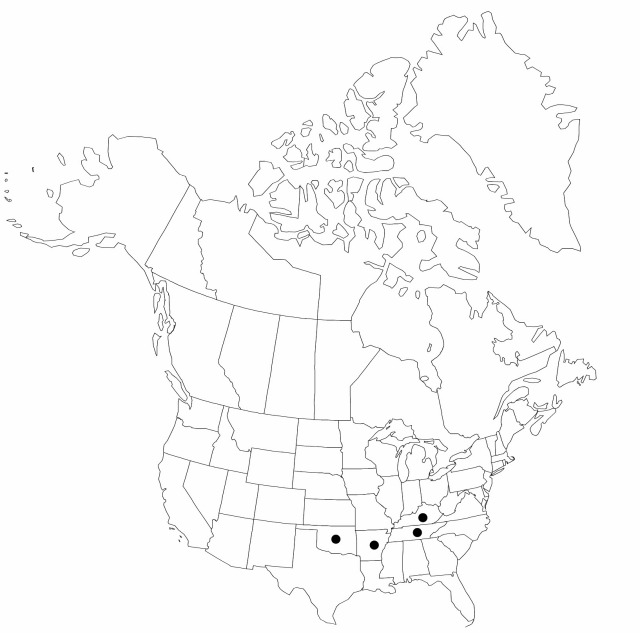Carex ouachitana
Ann. Missouri Bot. Gard. 74: 440, fig. 1. 1987.
Plants not cespitose; rhizome internodes 2–3.4 mm thick. Culms strongly purple-red or yellowbrown tinged with purple-red to 4.8–10.4 cm high at base, 20–60 (–68) cm. Leaves: sheaths glabrous; blades green, widest blades 2.4–5.1 (–6.7) mm wide, smooth abaxially. Inflorescences 0.21–0.57 (–0.95) of culm height; peduncles of lateral spikes scaberulous; peduncles of terminal spikes (2.5–) 18–121 mm, usually much exceeding lateral spikes; proximal bract with sheaths tight, abaxially glabrous, sheath front apex concave, elongated 0.2–2.5 mm; ligules 0.2–4.3 mm; distal bract shorter than terminal spike. Spikes 1–3, widely separate; lateral spikes pistillate or androgynous, with 3–13 (–22) perigynia, (19–) 13–39 × 3.9–8.3 mm, ratio of spike length (in mm) to flower number = 1.7–3.4; terminal spikes (16–) 20–43 × (2.8–) 3.3–4.5 (–5.4) mm. Pistillate scales 3.3–11.1 (–17.9) × 2–2.8 mm, margins entire, whitish, apex with awn 0.2–8.3 (–13.7) mm. Staminate scales 4.2–5.7 × 1.2–1.6 mm. Anthers 2.4–4.4 mm. Perigynia spirally imbricate, 42–65-veined, unwrinkled, obovoid or narrowly obovoid, obtusely triangular in cross-section, 3.4–5.1 × 1.5–2 mm, 1.8–2.5 (–3.2) times as long as wide, dull, base gradually tapered, apex gradually or abruptly tapered to subacute; beak absent or excurved, 0–0.4 (–1.2) mm. Achenes obovoid, 2.6–3.4 × 1.4–1.8 mm, tightly enveloped by perigynia; stipe 0.1–0.3 (–0.6) mm, bent 30–60°; beak bent 35–80°, 0.25–0.45 mm.
Phenology: Fruiting spring.
Habitat: Mesic to dry-mesic, rocky, deciduous or deciduous-pine forests, usually in loams on slopes or ridgetops
Elevation: 200–800 m
Distribution

Ark., Ky., Okla., Tenn.
Discussion
Though it has a restricted distribution and is local, Carex ouachitana is often abundant where it occurs.
Selected References
None.
Lower Taxa
"shortened" is not a number."high" is not a number.
